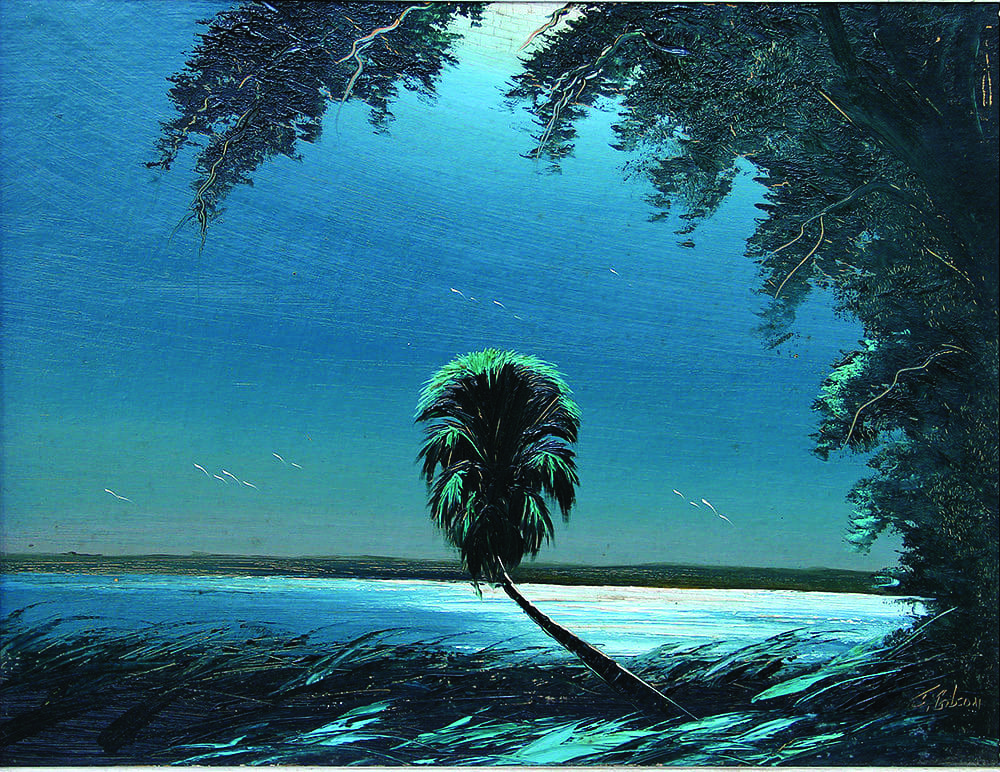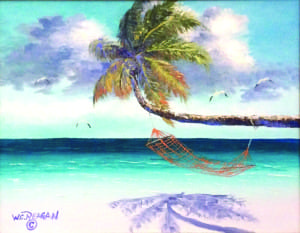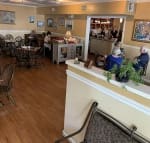Florida Highwaymen Exhibit – Preview March 18th and Show on March 19th
Florida Highwaymen Exhibit
Saturday, March 19, 2016
10am-5pm
Sample-McDougald House
450 NE 10 Street, Pompano Beach
Admission is $5 per person
Preview Night
Friday, March 18, 2016
5:30pm-8:30pm
Admission is $35 and includes food and beverages and entertainment
To purchase tickets call 954 691-5686.
floridahighwaymenpaintings.com/search
For more information about the Florida Highwaymen art show and sale, please call Lee Waldo at 954 691-5686.

It’s difficult for anyone to make it as painter. Now imagine being African-American in 1950s Florida and trying to earn a living as an artist. But a group of painters who would later become known as the Florida Highwaymen did not give up. As no galleries would show their works, the artists sold their paintings out of the trunks of their cars on the roadside to passing tourists—and so their group became aptly named—The Florida Highwaymen. For years this group of artists were largely unknown in the high-brow art world. Now, their works are in major museums, the Governor’s Mansion and even the White House. While their movement may not have the same cache as impressionism or cubism, for Floridians, it’s as if we have our very own Hudson River Valley School— a group of inspired artists preserving our states natural beauty with every stroke.
The landscapes depicted by the Highwaymen are quintessential Florida scenes— scrubby palmettos, glorious sunsets, beach scenes and of course royal poincianas in all their glory. The colors are vibrant and vivid—orange sunsets, impossibly green trees and clouds layered with pinks and purples—capturing a visceral beauty unique to Florida. They often painted from memory—and now that so much of our state has been developed, these painting are even more treasured. The men (and women) used oil paints and often painted on Upson board as opposed to traditional canvas. They framed their works with crown moldings—using any materials they could to reduce costs. They worked quickly and often they painted together. The more they could paint, the more they could sell. The group painted during the 1950s to the 1980s selling many of their work from on the side of A1A up and down the East coast of Florida.
Currently, many of the artist have passed or moved on to other ventures, but a few are still active and creating visions of our vast Florida landscape for new generations to enjoy.
The March show at the Sample-McDougald House will feature the works of nine Highwaymen and is one of the largest public gatherings of Highwaymen at a single venue.
Curtis Arnett
As one of the youngest Highwaymen, Curitss Arnett was inspired to paint at an early age, he attributes most of his success to his mentor Hezekiah Baker. His paintings grew from scenes of palm trees and rivers to seascapes and depictions of Florida’s interior. His later works stand out from other Highwaymen’s landscapes because they are created using acrylics, a water-soluble paint that dries more quickly than oils and is better for painting sharp edges. He is best known for his works centering on cypress trees, swamp scenes and hammocks. He plays with reflections in the water, with both shape and color. His work is dreamy and serene, evoking a calm peacefulness.
Al Black
Al Black says he’s been talking all his life and his stories reflect the continuous contests he has with his customers and those in power over him. He readily explains with pride, “I know how to talk with white people. See, I was born and raised in Jackson, Mississippi. I know what to say out of my mouth.” He was taught that if he didn’t speak correctly in the presence of whites, he might get lynched. He’d seen people get killed for mouthing off, and his mother taught him how to speak carefully in order to stay safe. No matter what the Highway Patrol called him when they stopped him on the road, his response was always “yes sir.” Al Black tells many tales of his grand successes. In spite of not having a driver’s license, he drove a cotton truck when he was 13 or 14. At the young age of 15, he left home to labor in the fields with the migrant workers after his black supervisor told his mother he’d take care of him.
Willie Daniels
Willie Daniels’ paintings are technically skilled and emotionally strong. He grew up watching his neighbors Harold Newton and Roy McLendon paint. Some say his landscapes are so powerful they can be mistaken for Harold Newton’s masterworks. He clearly has expertise with a paintbrush and a palette knife. He began by painting several works at one time, trying to create as many as he could like Alfred Hair and Livingston Roberts. He used Upson board like the other painters and later began working on Masonite, wood and canvas. His oaks are gnarly, his oceans inviting and his colors vivid. The compositions are traditional Highwaymen scenes, but he has a style that is his own. When he is at his best, his approach is impressionistic and skilled. His works seem to be created with ease, as if painting literally flows from his hand. His night scenes are dreamy and mysterious, evoking an interior landscape of the mind. Occasionally, he places small figures in his compositions, but the power of his work is in his feeling for the land.
James Gibson
James Gibson is one of the most active Highwayman painters and perhaps the most successful. He has consistently made a living selling landscapes and has received numerous awards for his excellent paintings. Always a snappy dresser, he claims the key to his success is to “respect people, don’t give up, and put god first. “Everything else,” he says, “will fall into place.” After creating the background of his landscapes, he paints in the dark colors; the brighter colors go on top, making the artwork come alive. His early frames, like those of other Highwaymen, were made from crown molding. He later started purchasing frames that weren’t selling; now he purchases a variety of frames that he likes. He selects simple frames that won’t detract from his paintings. He likes to visualize the frame and the painting working together.
Doretha Hair Truesdell
Doretha Hair Truesdell was there from the very beginning. Truesdell is one of the two original women who became a part of the legendary Highwaymen. Her husband was one of the founders. Before his tragic death, her late husband, Alfred Hair painted under the ghost name “Freddy” for a year because he was told that his own signature cheapened the art. The paintings under the name “Freddy” are a collaboration of husband and wife, with Doretha painting some of the basic elements like the skies and backgrounds and Hair adding the details like trees, shadows, birds and people. She also painted alongside her brother, Carnell Smith, who is one of the youngest Highwaymen in the Florida Artist Hall of Fame. After Alfred was killed he and Doretha, like so many others, he grieved deeply. Doretha and Carnell tried to pick up the pieces of their lives together. They painted the foregrounds of the landscapes that Alfred would have painted had he lived. They started painting their own pictures. Doretha has yet to be named as Highwayman, or rather, Highwaywoman.
John Maynor is talented in so many ways. He paints portraits as well as landscapes and he renders signs for advertising. He repurposes tossed out items and makes use of space in unusual ways. In John’s creative mind, an old shoe becomes a planter and a yard space turns into a gym. Known about town as “the man on a bicycle with a paintbrush,” today, John is a man on a mission to succeed.John Maynor’s paintings are distinguished by the texture in his trees, which he builds up with a palette knife. He likes to paint fiery skies and he makes his waterways shine by giving them a coat of linseed oil. His work is all about creating an atmosphere. When asked how he knows when he’s created a good painting, he replies that he knows it when it sells. It takes John longer to make a painting than it used to. When he was young he would make two to three paintings a day. He now takes a week to make two to three. He’s having trouble with his hand that partially slows him down. Regardless of how he feels, he says, “Art is on my mind everyday.”
Roy McLendon is known for his narrative landscapes that depict the daily life of his neighbors. His subject matter is perhaps the most diverse of all the Highwaymen. Unlike most of the other painters in the group, Roy is comfortable including people in his scenes. It is Roy’s subject matter that sets him apart from the other Highwaymen, as it is more wide ranging. He paints traditional Highwaymen landscapes such as ocean scenes with waves crashing onto the beach and palm trees swaying in the breeze. But he also paints still lifes, houses, figures, and animals, suggesting a narrative. Laundry dries on a clothesline, women work in the yard, and a mother and child walk down a dirt road to go fishing. Roy’s environments are, therefore, often places people inhabit. Roy McLendon sees himself and his community as part of nature, and not separated from it.


Perhaps more than any other Highwayman, Charles Walker carefully studies the landscape as part of his creative process. Charles is not, nor has he ever been, a fast painter. Rather, he carefully considers every aspect of his paintings, most often incorporating animals into his scenes.Walker taught himself to paint and never stops his educational process. He says his “mind is always open to learning.” He studies the work of other artists to become a better painter, and he recognizes that the natural environment can be a teacher. Like many other nature artists, he’s an observer. There is an oak tree in a park that he has studied for years. He often paints it with different animals in and around it. He thinks about the beauty around him and the ecological balance in the world. Charles understands that everything is always changing, and he mourns the loss of Florida’s wilderness. He works on two or three paintings at a time in his home studio. Photographs help him depict his subject matter in a realistic fashion. He uses natural colors in an effort to duplicate nature. Sometimes he sketches and sometimes he works directly on the canvas. It often takes a month and a half to finish one work.
Today, the Highwaymen are well known for their dazzling landscapes and their skill at selling them on the roadways during Jim Crow times. That might be enough; but their stories are more than that. They are about vivid worlds and vivid lives. Put together, the Highwaymen story is about working the fields, (mostly) male camaraderie, Florida’s roadways before the interstate, salesmanship, and desire. It’s about the experience of living in Florida’s heat and humidity without air-conditioning, sharing beers, counting money, and dreaming about a better future. It is also about Joe Frazier, Jim Crow, the Civil Rights Movement, the railroad tracks, and blacktowns and whitetowns across the South. It’s about one white artist who opened up his home and studio to countless dreamers from all walks of life when this kind of thing just wasn’t done. And it’s about a kind of rhythm that comes from Motown, the blues, jazz, gospel, and the sounds of nature. The Highwaymen’s future, in some ways, is about our collective past and our collective future. For these men and one woman, and all those who have learned from them, the future is about understanding the potential of choosing a poetic place in the world. The Highwaymen will be remembered for their grit and determination. They are role models for all of us, not as perfect human beings, but individuals who struggled, sometimes failed, but ultimately transcended their designated roles through artwork. Knowing their stories is to know them as creators of their worlds, undeterred by circumstances of poverty and race. Remembering them is to gain insight into what community once meant to black people, in spite of the fact that their community was horribly restricted by outside forces. Remembering them is to know our history and how the slightest act of resistance to oppression can be powerful.







